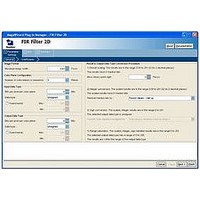IPS-VIDEO Altera, IPS-VIDEO Datasheet - Page 127

IPS-VIDEO
Manufacturer Part Number
IPS-VIDEO
Description
MegaCore Suite W/ 17 DSP Video/image Processing Functions
Manufacturer
Altera
Type
-r
Specifications of IPS-VIDEO
Software Application
IP CORE, SUITES
Supported Families
Arria GX, Cyclone II, HardCopy II, Stratix II
Core Architecture
FPGA
Core Sub-architecture
Arria, Cyclone, Stratix
Rohs Compliant
NA
Function
Suite of IP Functions for Video and Image Processing
License
Initial License
Lead Free Status / RoHS Status
na
Lead Free Status / RoHS Status
na
- Current page: 127 of 214
- Download datasheet (6Mb)
Chapter 5: Functional Descriptions
Deinterlacer
May 2011 Altera Corporation
Frame Buffering
1
1
4. Two pixels are selected for interpolation by examining the 3×3 group of pixels
5. The function uses a weighted mean of the interpolation pixels to calculate the
The motion-adaptive algorithm requires the buffering of two frames of data before it
can produce any output. The Deinterlacer always consumes the three first fields it
receives at start up and after a change of resolution without producing any output.
The weave and motion-adaptive algorithms cannot handle fields of different sizes (for
example, 244 lines for F0 and 243 lines for F1). Both implementations discard input
fields and do not produce an output frame until they receive a sufficient number of
consecutive fields with matching sizes.
Pass-Through Mode for Progressive Frames
In its default configuration, the Deinterlacer discards progressive frames. Change this
behavior if you want a datapath compatible with both progressive and interlaced
inputs and where run-time switching between the two types of input is allowed.
When the Deinterlacer lets progressive frames pass through, the deinterlacing
algorithm in use (bob, weave or motion-adaptive) propagates progressive frames
unchanged. The function maintains the double or triple-buffering function while
propagating progressive frames.
Enabling the propagation of progressive frames impacts memory usage in all the
parameterizations of the bob algorithm that use buffering.
The Deinterlacer MegaCore function also allows frame buffering in external RAM,
which you can configure at compile time. When using either of the two bob algorithm
subtypes, you can select no buffering, double-buffering, or triple-buffering. The
weave and motion-adaptive algorithms require some external frame buffering, and in
those cases only select double-buffering or triple-buffering.
When you chose no buffering, input pixels flow into the Deinterlacer through its
input port and, after some delay, calculated output pixels flow out through the output
port. When you select double-buffering, external RAM uses two frame buffers. Input
pixels flow through the input port and into one buffer while pixels are read from the
other buffer, processed and output.
from the more recent two fields for edges. If the function detects a diagonal edge,
the function selects two pixels from the current field that lie on the diagonal,
otherwise the function chooses the pixels directly above and below the output
pixel.
1
output pixel and the equivalent to the output pixel in the previous field with the
following equation:
The 4:2:2 compatibility mode prevents incorrect interpolation of the chroma
samples along the diagonal edges.
Output Pixel = M .
Upper Pixel + Lower Pixel
2
Video and Image Processing Suite User Guide
+ (1 - M) . Still Pixel
5–43
Related parts for IPS-VIDEO
Image
Part Number
Description
Manufacturer
Datasheet
Request
R

Part Number:
Description:
CYCLONE II STARTER KIT EP2C20N
Manufacturer:
Altera
Datasheet:

Part Number:
Description:
CPLD, EP610 Family, ECMOS Process, 300 Gates, 16 Macro Cells, 16 Reg., 16 User I/Os, 5V Supply, 35 Speed Grade, 24DIP
Manufacturer:
Altera Corporation
Datasheet:

Part Number:
Description:
CPLD, EP610 Family, ECMOS Process, 300 Gates, 16 Macro Cells, 16 Reg., 16 User I/Os, 5V Supply, 15 Speed Grade, 24DIP
Manufacturer:
Altera Corporation
Datasheet:

Part Number:
Description:
Manufacturer:
Altera Corporation
Datasheet:

Part Number:
Description:
CPLD, EP610 Family, ECMOS Process, 300 Gates, 16 Macro Cells, 16 Reg., 16 User I/Os, 5V Supply, 30 Speed Grade, 24DIP
Manufacturer:
Altera Corporation
Datasheet:

Part Number:
Description:
High-performance, low-power erasable programmable logic devices with 8 macrocells, 10ns
Manufacturer:
Altera Corporation
Datasheet:

Part Number:
Description:
High-performance, low-power erasable programmable logic devices with 8 macrocells, 7ns
Manufacturer:
Altera Corporation
Datasheet:

Part Number:
Description:
Classic EPLD
Manufacturer:
Altera Corporation
Datasheet:

Part Number:
Description:
High-performance, low-power erasable programmable logic devices with 8 macrocells, 10ns
Manufacturer:
Altera Corporation
Datasheet:

Part Number:
Description:
Manufacturer:
Altera Corporation
Datasheet:











